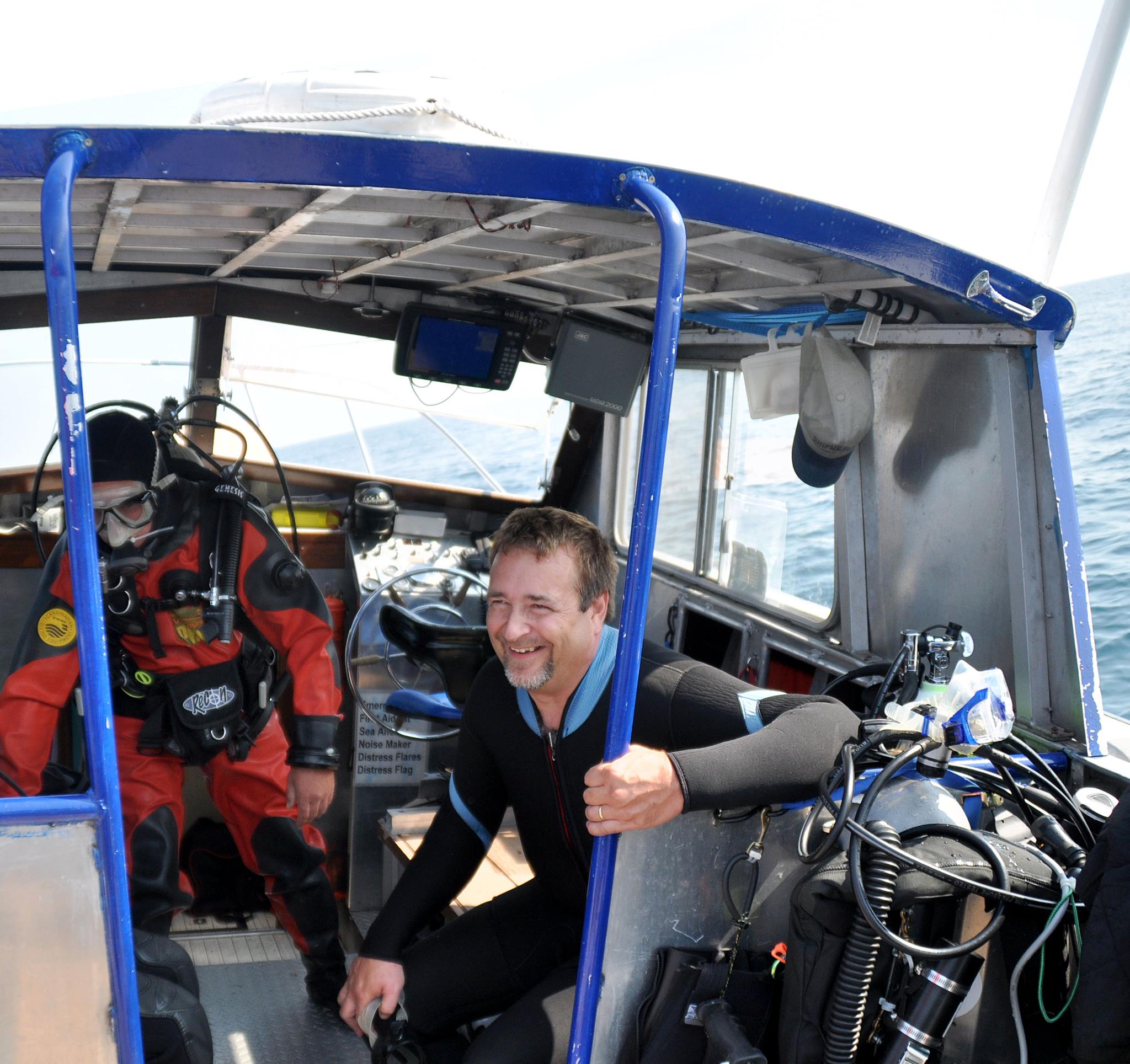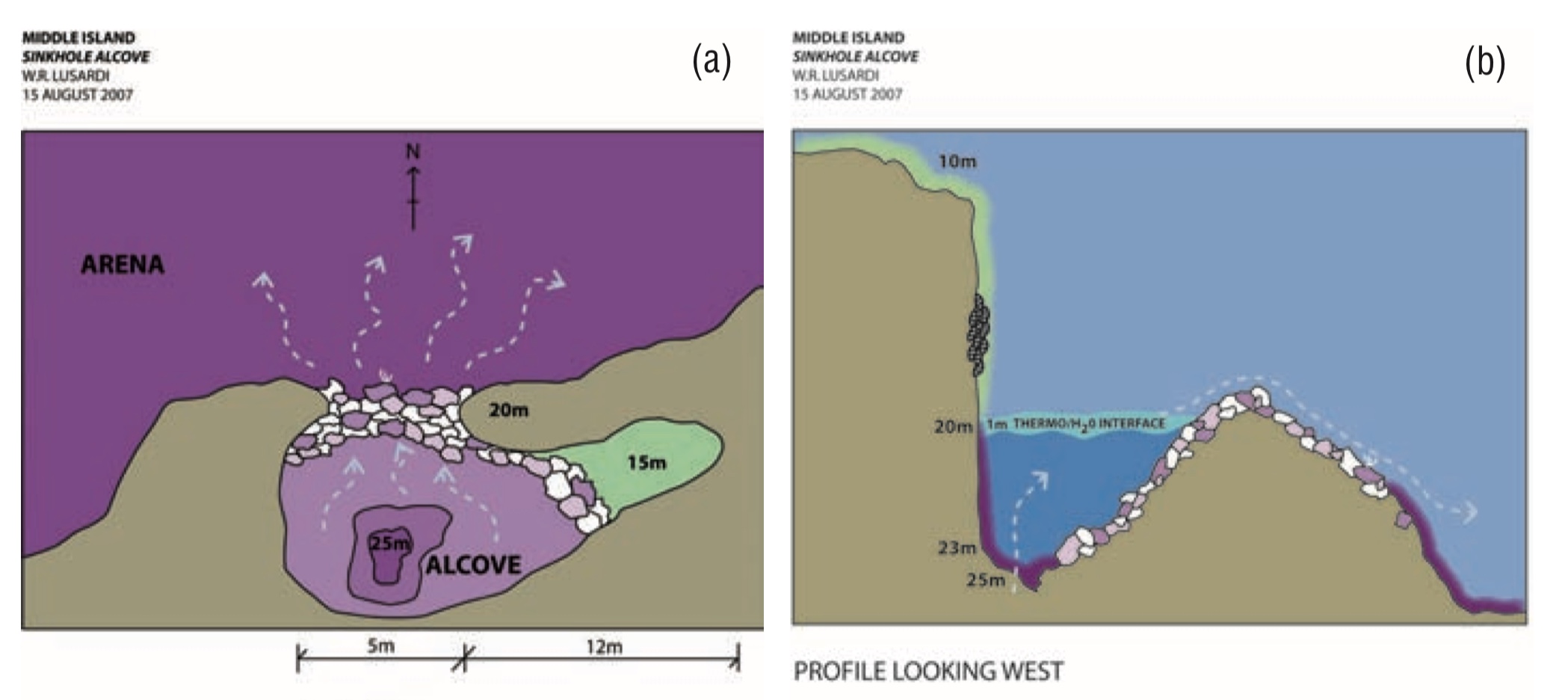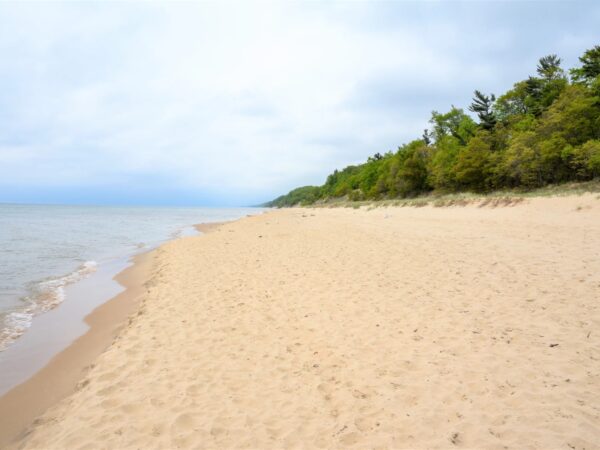
With an amazing collection of freshwater and saltwater vessels found in the Thunder Bay National Marine Sanctuary, I have to admit diving a sinkhole didn’t have much appeal.
Divers have been talking about these unique holes north of Alpena for decades, but a full investigation into what they were and how many existed only started in 2001. In late July 2012, I was invited aboard the Thunder Bird II, a dive charter boat based out of Alpena, with plans to dive a recently discovered shipwreck called the DM Wilson, as well as film the Nordmeer for my documentary, “Cutter Rescues”.
Both dives went off perfectly, and our charter captain Joe Sobczak wondered if we had interest in diving a third time. The answer is always ‘yes’ to bonus dives, and we took a brief break on the surface to allow us to go a bit deeper into the geological formation near Middle Island.
Middle Island Sinkhole is about 2 miles offshore in about 70 feet of water. It’s an area of lakebed that was an underwater limestone cavern that collapsed and left a crater over 100 feet in diameter. Divers don’t see much difference jumping in, as the lake looks the same as you descend, but the hole’s uniqueness is unmistakable as you see the edge and begin sinking into the crater itself.

The sinkhole looks like an abandoned quarry as you glide over the edge. Large boulders have collapsed into a deep ravine that you can only see parts of due to the limits of underwater visibility. You need to equalize your ears as you go over the cliff, and as it gets darker you realize the sides are coated in a thick dark mat of what looks like algae.
Other areas have large white sections that are easy to distinguish from the darker rock and sand. As you look closer at the white patches you see they are waving in what appears to be current. Another difference is a layer of water that looks like you’re staring into petroleum jelly. Divers normally associate this with a temperature difference, but the sinkhole distortion is what scientists call a chemocline. Samples of the water show this is because it’s actually groundwater instead of lake water. The source of this flow is very apparent when you reach the side that has an alcove carved out, showing what is essentially an underwater artesian well.

Descent into a sinkhole
Another outflow is apparent in a cone-like vent. This reminded me of a giant version of a beach insect I used to see on Lake Michigan’s beaches. Luckily, there’s no massive antlion awaiting the bottom of this sinkhole vent!
Invasive round gobies guard the rim of the sinkhole and we saw a single walleye patrolling for food near the top, but nothing was visible in the void of the sinkhole. A chat with my friends at NOAA would later explain that the increased concentrations of sulfur in the hole discourage fish.
Scientists told me the purple mats I saw on the walls of the sinkhole were cyanobacteria, but because I was also diving without a light, it nearly eliminated my ability to see reds and purples underwater.
The flow of the underwater ‘spring’ is apparent when you watch the fingerlings near the alcove in the southern section of the hole. These white bacteria dance ever so slowly as the cooler water mixes with Lake Huron. Fluctuations in the flow from the water beneath Alpena County can be warmer and colder than the lake, depending on the time of year and turnover of the lake. For a good understanding of the alcove area, please refer to the diagram drawn by Michigan’s underwater archeologist Wayne Lusardi.
I was lucky to return to the sinkhole with divers Ron Bloomfield and Matt Crews in 2013. This time we each brought cameras because we really didn’t believe people would comprehend our verbal descriptions of the alien environment found just off Michigan’s shoreline.
I highly recommend a visit the next time you bring your scuba gear to Michigan’s northern Lower Peninsula!
Watch Great Lakes Now’s monthly show segment about the sinkholes and what they could mean for the lakes:
5 Comments
-
Any man-made stuff in the sinkhole? Seems it would have been a good place to dump stuff during the Industrial Revolution.
-
Author
Sadly, it was a ‘convenient’ place to dump old cars and appliances back in the day. A massive cleanup was held to clean one of the sinkholes up.. and luckily the holes I’ve dove into were debris-free! Ric
-
-
Ric
I really enjoy your articles. You have the best shipwreck stories.
-
Author
Thanks so much Dave! I really love sharing stories about the Great Lakes. You’ll find a lot more on http://www.greatlakesNow.org or check out my podcasts at http://www.shipwreckpodcast.com. Thanks for your comment- Ric
-
-
I would like to get in contact with Ric Mixter concerning the sinkholes in Alpena area where I did extensive water quality analyses on them and flowing wells. This is relative to the Great Lakes Now program seen last month on CMU-TV.




